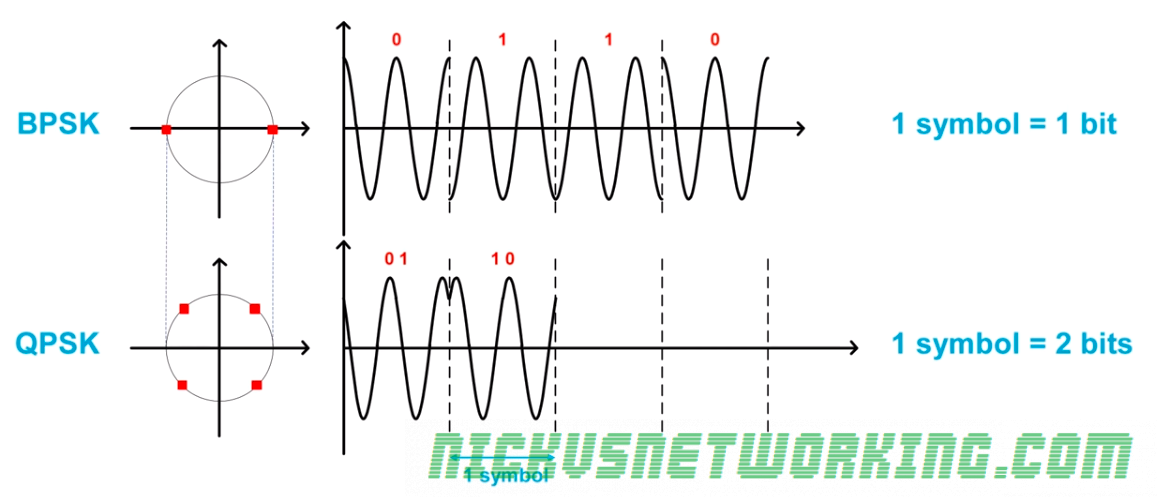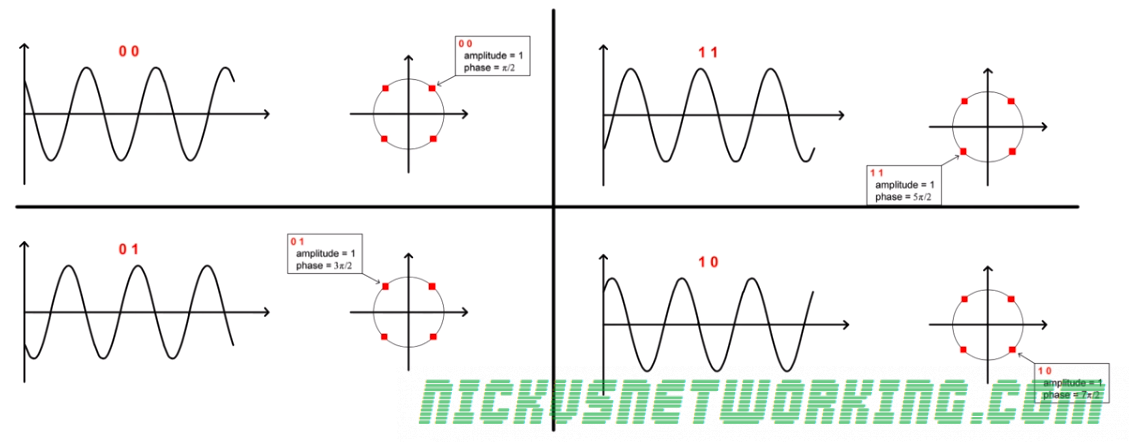These are my lecture notes from IMT’s NET02x (4G Network Essentials) course, I thought I’d post them here as they may be useful to someone. You can find my complete notes here.
The E-UTRAN relies on Phase Shift Keying to modulate data.
The downlink uses orthogonal frequency division multiplex (OFDM) while the uplink uses SC-FDMA due to OFDM’s high peak-to-average-power ratio making it unstable for uplink due to power consumption requirements.
Binary Phase Shift Keying (BPSK)
The simplest modulation is Binary Phase Shift Keying, allowing the phase to be left unmodified to encode a 0, or offset by 180 degrees (aka π) to transmit a 1.
While each bit of data is being transmitted, the time it is being sent over the air is referred to as the symbol length.

Quaternary Phase Shift Keying (QPSK)
QPSK adds to additional phase states, to allow us to send twice as much data in one symbol.
This is done by defining more than two states (phase unmodified, phase offset by pi), but rather 4 states:
| Data | Phase Offset |
| 00 | π/2 |
| 11 | 5π/2 |
| 01 | 3π/2 |
| 10 | 7π/2 |
This means we can transmit double the number of bits in a single symbol, with QPSK we can now transmit 2 bits per symbol as per the table above.
This means the data rate of QPSK is twice that of BPSK.

BPSK vs QPSK
Thanks to interference, drift, Doppler shift etc, our modulated data probably isn’t going to be received at exactly the same offset that it was sent.
So because our phase shift isn’t going to land exactly on the red dot in the circle, but somewhere nearby.
The receiver will determine the phase of the signal based on it’s proximity to a known phase shift angle.
Because QPSK has more phase states than BPSK we get a higher data rate, but as the recieved data isn’t going to be exactly the phase offsets defined, the states may overlap and the receiver will not receive the correct information

Channel conditions restrict the modulation techniques we can use. BPSK is slower but more reliable, while QPSK is faster but more error prone due to it’s lower tolerances.
Transmission Reliability
Error Correction is needed in LTE to make sure the message can be reconstructed correctly by the reciever.
To do this, in a simple form LTE adds redundant data.
For example sending 3 copies of the data increases the chance one will get through correctly, and provides the receiver with information to discriminate the right data.
(If only two copies were sent to increase the reliability, the receiver wouldn’t know which one was the correct one.)
Let’s take an example of sending the message “Hello World” and look at the 3 copies sent.
| Copy 1: Helso Wdrld |
| Copy 2: H1llo Worlp |
| Copy 3: qello Uorld |
| Correct Data: Hello World |
By looking at what’s common we can see that the first letter is H in the first to copies, but not in the third copy, so we can say with some surety that the first letter is H.
The second letter is e in copy 1 and copy 3, so we can again say the second letter is e.
This is a simplified example of coding the data with redundant data to aid in reconstruction.
The ratio of useful information / total transmitted is called the coding rate.
LTE coding rates can vary from 1/3 for extensive error correction, to close to 1 for almost no error correction.
Modulation Coding Scheme (MCS)
As channel conditions change continuously for each terminal/UE, LTE has to change the modulation technique and coding rate dynamically as channel conditions change for each terminal/UE.
The Modulation Coding Scheme is the combination of modulation and coding scheme used, and this changes/adapts in real time based on the signal conditions, independently for each terminal/UE.
There are 29 MCS combinations in LTE.
